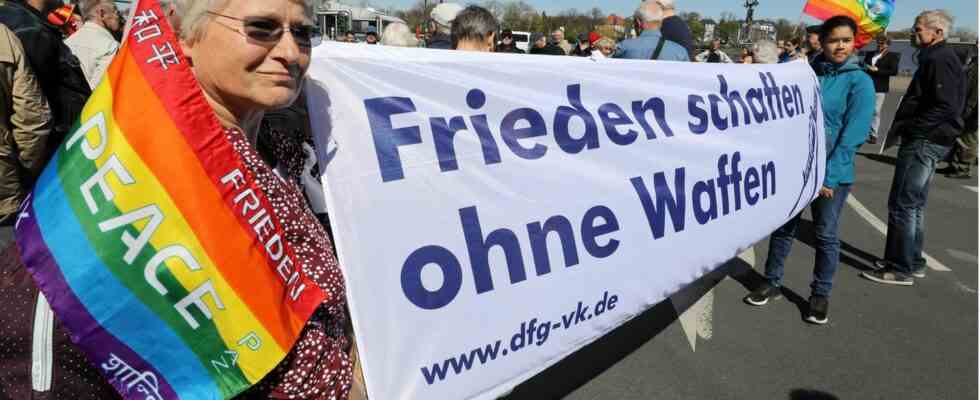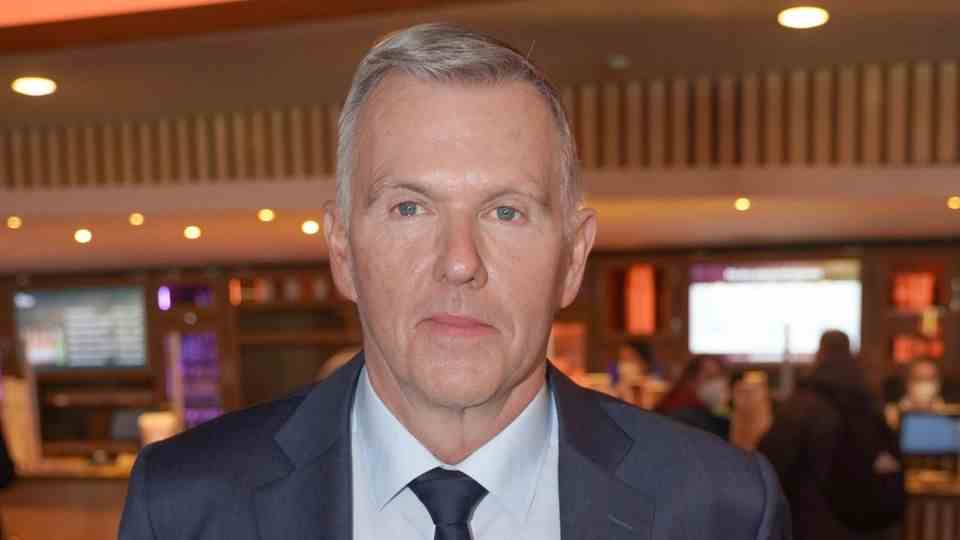Everyone is currently feeling for arms deliveries – even Anton Hofreiter suddenly knows his way around types of tanks and precision rifles. Is it naive to demonstrate for peace now?
War in Europe – that should actually give wings to the German peace movement and bring huge crowds to the Easter marches. As popular as in the early 1980s, when hundreds of thousands took to the streets against the NATO double-track decision-making process, making a significant contribution to the fall of the then highly controversial SPD chancellor, Helmut Schmidt. But whether such scenes will really be repeated next weekend is uncertain.
The number of rallies has increased significantly to over 100 compared to last year, says Kristian Golla from the Peace Cooperation Network in Bonn, which coordinates the Easter marches nationwide. But as far as the number of participants is concerned, it will have to be seen “whether pictures like those of the civilians killed in Butscha are more likely to mobilize or perhaps reinforce resignation”. Two weeks after the big peace demonstration in Berlin at the beginning of March with 500,000 participants, only half came together at rallies in four different places. A difference to previous threats is that now declared leftists are vehement advocates of armed resistance. This applies, for example, to the Greens, which also emerged from the peace movement in 1980. Anton Hofreiter from the left wing of the party recently presented himself to “Markus Lanz” as a newly qualified military specialist and campaigned for the delivery of heavy weapons.
What does it mean when Toni Hofreiter becomes a weapons expert at “Lanz”?
“I’ve dug myself very deep there in the last few weeks,” he reported to the visibly puzzled moderator. “Poland has PT-91s, which are upgraded T72s.” The fact that these are tank types could not be explained in the program, because Hofreiter went on straight away: “In my opinion, this also includes something like heavy sniper rifles, G82, which has a 12.7 millimeter projectile. You can use it to shoot the armored Russian National Guard vehicles break up, which basically means you shoot the people in there.” Yes, those were actually Hofreiter’s words.
“Create peace without weapons” – this old core demand of German pacifism seems to have been called into question, if not discredited, by the Ukraine war. “And that’s because Putin simply doesn’t respect something like that,” says political scientist Ulrich Kühn from the Institute for Peace Research in Hamburg. “In this respect, in my opinion, the classic slogans of the German peace movement fizzle out here.”
The FDP politician Alexander Graf Lambsdorff goes much further and describes the participants in the Easter marches in a guest article for “Zeit” as “Vladimir Putin’s fifth column”. The foreign policy expert writes: “When Easter marchers now call for disarmament and in interviews suggest “non-violent support” for Ukraine, they spit in the face of the defenders of Kiev and Kharkiv.”
Is it naive to demonstrate for peace?
Is it naïve or even harmful to demonstrate for peace in the face of the atrocities against civilians in Bucha and the rocket attack on a train station in Kramatorsk filled with refugees? From a pacifist point of view, the following applies first of all: those who reject armed violence can at the same time support non-violent resistance. The poignancy of the images of unarmed Ukrainian civilians pushing back Russian tanks was reminiscent of Mahatma Gandhi (1869-1948) and his Satyagraha fighters.
The pacifist leader of the Indian independence movement wanted to endure suffering and pain and even death in order to soften the opponent’s heart in the long term. In the fight against the British Empire, Gandhi achieved spectacular success with this method. When the objection was raised that his peaceful actions would hardly impress opponents like Hitler’s Germany, he replied: “I refuse to believe that the Germans as a nation have no heart or considerably less than the other nations in the world.”
At the latest after the Holocaust and the Second World War, Gandhi’s attitude appeared as a downright culpable denial of reality. Even Putin will hardly be defeated with non-violent resistance. Federal Foreign Minister Annalena Baerbock (Greens) is therefore demanding that Germany also hand over heavy weapons to Ukraine. In concrete terms, this means: tanks, fighter jets, warships or artillery pieces.
The issue of arms deliveries is a controversial topic among peace activists. Parts of the peace movement have spoken out against it, since weapons only prolong the conflict and threaten a spiral of escalation. Kühn, an arms control expert, counters this: “It should be at the discretion of those who are attacked whether they want to defend themselves with weapons. And Ukraine has signaled that very clearly.”
“We must think of the war from the end”
Surprisingly, it is sometimes the military who are the most cautious on talk shows. Among them is the retired Brigadier General Erich Vad, former military policy adviser to Chancellor Angela Merkel. He is against the delivery of heavy weapons. “We’re doing a lot of war rhetoric at the moment – out of good intentions in terms of ethics,” says Vad of the German Press Agency. “But, as is well known, the road to hell is always paved with good intentions. We have to think through the end of the ongoing war between Russia and Ukraine. If we don’t want World War III, sooner or later we have to get out of this logic of military escalation and start negotiations record, tape.”
Here the general is entirely in line with the peace movement. “What should the alternative be?” asks Kristian Golla. “Do you want to defeat Russia?” The most important task at the moment is not to bring Putin before the International Criminal Court in The Hague – desirable as that would be – but to end the terrible war.
Vad agrees. The security expert and military analyst assumes that Putin has given up the regime change he originally wanted in Ukraine after the extensive withdrawal from the Kyiv area. “That’s why the chances for negotiations are actually not bad. Both sides could come out of it face-saving,” says the military analyst.
On the other hand, it can now be argued that the Austrian Chancellor Karl Nehammer tried to get in touch with Putin on Monday and apparently hit the rocks. Accordingly, the Kremlin ruler is currently fully focused on the announced major offensive in eastern Ukraine. “This battle will be fought with vehemence,” is Nehammer’s impression.
Kühn thinks it’s possible that Putin’s stance will change even if this attack falters. “If the Ukrainian army manages to stop the Russians again, then it’s really possible that Putin will somehow try to get out of the matter by negotiating a face-saving solution,” believes Kühn.
Putin could take the world down with him
Others are less optimistic. “We will not capitulate. Never. We can perish. But we will take a world with us” – the philosopher Svenja Flasspöhler recalled this quote from Hitler in a guest article for “Zeit”. “The German dictator did not yet have weapons of mass destruction. Putin, for whom no price seems too high for his idea of an empire, is in a different situation today.” He could tear the world down with him. Flasspöhler’s conclusion is: “Anyone who takes part in an Easter march warns against adapting to Putin’s warlike logic and thus falling back into the past.”




